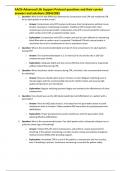Exam (elaborations)
Exam (elaborations) AACN-ADVANCED LIFE SUPPORT AND PROTOCOL
- Course
- Institution
AACN-Advanced Life Support Protocol questions and their correct answers and solutions 2024/2025 1. Question: What are the key differences between the compression-only CPR and traditional CPR for an adult patient in cardiac arrest? o Answer: Compression-only CPR involves continuous chest compr...
[Show more]



